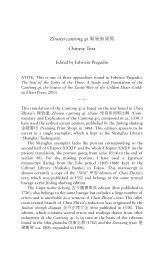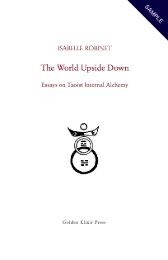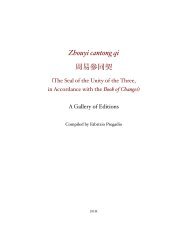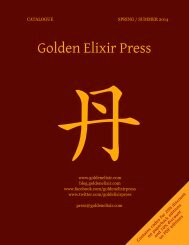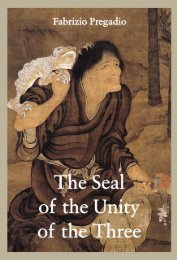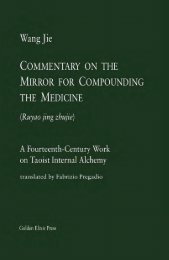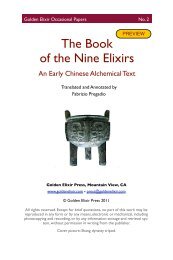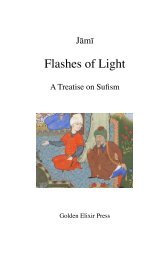The Seal of the Unity of the Three â Vol. 2 - The Golden Elixir
The Seal of the Unity of the Three â Vol. 2 - The Golden Elixir
The Seal of the Unity of the Three â Vol. 2 - The Golden Elixir
- No tags were found...
Create successful ePaper yourself
Turn your PDF publications into a flip-book with our unique Google optimized e-Paper software.
1. Tang Dynasty and Five Dynasties 117<br />
—————————————————————————————————————————<br />
(qian huanghua 鉛 黃 花 ), add it to quicksilver, refine it, and make a<br />
purple powder; <strong>the</strong>y take cinnabar, quicksilver, realgar, orpiment,<br />
laminar and nodular malachite, alum, and mica, and mix and refine<br />
<strong>the</strong>m to be fixed by fire; <strong>the</strong>y take <strong>the</strong> azure stones, <strong>the</strong> alums, <strong>the</strong><br />
green stones, and <strong>the</strong> ashes, mix <strong>the</strong>m with quicksilver and make red<br />
silver (hongyin 紅 銀 ), and <strong>the</strong>n again transmute it into powder; <strong>the</strong>y<br />
boil sulphur in o<strong>the</strong>r ingredients to make powder <strong>of</strong> jade; <strong>the</strong>y dye<br />
leaves <strong>of</strong> copper with sulphur, and refine <strong>the</strong>m into red cinnabar; <strong>the</strong>y<br />
transmute copper with arsenic, and shrink tin with iron. This is not<br />
what I do. Some say that gold, silver, copper, iron and tin are <strong>the</strong> five<br />
metals. O<strong>the</strong>rs say that realgar, orpiment, arsenic, alum, chalcanthite,<br />
laminar malachite, nodular malachite and alum are <strong>the</strong> eight minerals.<br />
I say: This is not what I mean. Zi 子 and wu 午 form <strong>the</strong> 3, wu 戊 and<br />
ji 己 make <strong>the</strong> 5. This is what I call <strong>the</strong> “eight minerals.” 20<br />
In his discussion, Liu Zhigu touches upon several subjects, including<br />
<strong>the</strong> emblematic roles <strong>of</strong> <strong>the</strong> Dragon and <strong>the</strong> Tiger; <strong>the</strong> symbolism<br />
<strong>of</strong> <strong>the</strong> five agents and <strong>the</strong> eight trigrams; and <strong>the</strong> cycles <strong>of</strong> <strong>the</strong> sixty<br />
hexagrams (associated with <strong>the</strong> thirty days <strong>of</strong> <strong>the</strong> month) and <strong>the</strong><br />
twelve “sovereign hexagrams” (bigua 辟 卦 , associated with <strong>the</strong> twelve<br />
months <strong>of</strong> <strong>the</strong> year). In doing so, he repeatedly quotes passages <strong>of</strong> <strong>the</strong><br />
Cantong qi. <strong>The</strong>se citations consist <strong>of</strong> four- and five-character verses<br />
found in different parts <strong>of</strong> <strong>the</strong> present version, and confirm that, by<br />
<strong>the</strong> mid-eighth century, <strong>the</strong> Cantong qi existed essentially in <strong>the</strong> same<br />
form as we know it today. Liu Zhigu quotes or alludes to <strong>the</strong> passage<br />
on <strong>the</strong> Flowing Pearl and <strong>the</strong> Green Dragon in section 28; several<br />
verses in section 41; <strong>the</strong> description <strong>of</strong> <strong>the</strong> cycle <strong>of</strong> <strong>the</strong> year in section<br />
51; <strong>the</strong> verses “<strong>The</strong> 9 reverts, <strong>the</strong> 7 returns, <strong>the</strong> 8 goes back, <strong>the</strong> 6<br />
remains” in section 55; <strong>the</strong> initial portion <strong>of</strong> section 64; and <strong>the</strong> verses<br />
on realgar and <strong>the</strong> eight minerals in section 87. Some verses from <strong>the</strong><br />
“Song <strong>of</strong> <strong>the</strong> Tripod” (“Dingqi ge” 鼎 器 歌 ) are also quoted. O<strong>the</strong>r<br />
significant details are <strong>the</strong> references to passages in sections 23 and 58<br />
as found in <strong>the</strong> first (“upper”) and <strong>the</strong> second (“middle”) Books<br />
(shangjing 上 經 and zhongjing 中 經 ) <strong>of</strong> <strong>the</strong> Cantong qi, respectively.<br />
This attests that by <strong>the</strong> mid-eighth century <strong>the</strong> Cantong qi was already<br />
divided into three parts.<br />
20<br />
Daoshu, 26.5b-6a (<strong>the</strong> corresponding text in <strong>the</strong> Quan Tang wen,<br />
334.19a, is much shorter). For <strong>the</strong> final sentences on <strong>the</strong> “eight minerals,”<br />
compare Cantong qi 32:1–4.<br />
Visit <strong>the</strong> Web page on this book • www.goldenelixir.com



